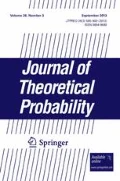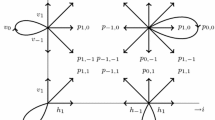Abstract
We prove an upper large deviation bound on the scale of the mean for a symmetric random walk in the plane satisfying certain moment conditions. This result complements the study by Phetpradap for the random walk range, which is restricted to dimension three and higher, and of van den Berg, Bolthausen and den Hollander, for the volume of the Wiener sausage.
Similar content being viewed by others
Notes
Note that a variety of probability measures is being used throughout the text. As a rule of thumb, mathbb denotes a measure on continuum objects, while standard font refers to discrete random variables. For more details, see Sect. 5.
see Equation (1.8) in that reference and apply a change of variables \(u\mapsto a/u\).
References
Asselah, A., Schapira, B.: Deviations for the Capacity of the Range of a Random Walk (2018). arxiv preprint arXiv:1807.02325
Asselah, A., Schapira, B., Sousi, P.: Capacity of the range of random walk on \({\mathbb{Z}}^4\). Ann. Probab. 47, 1447–1497 (2019)
Asselah, A., Schapira, B., Sousi, P.: Capacity of the range of random walk on \({\mathbb{Z}}^d\). Trans. Am. Math. Soc. 11, 7627–7645 (2018)
Bass, R. F.; Chen, X. and Rosen, J., Moderate deviations for the range of planar random walks. Mem. Am. Math. Soc., 198, viii+82 pp (2009)
Bass, R.F., Kumagai, T.: Laws of the iterated logarithm for the range of random walks in two and three dimensions. Ann. Probab. 30, 1369–1396 (2002)
Bolthausen, E.: Markov process large deviations in \(\tau \)-topology. Stoch. Process. Appl. 25(1), 95–108 (1987)
Chen, X.: Random Walk Intersections: Large Deviations and Related Topics Mathematical Surveys and Monographs. American Mathematical Society, Providence (2010)
Dvoretzky, A., Erdős, P.: Some problems on random walk in space. In: Proceedings of the Second Berkeley Symposium on Mathematical Statistics and Probability, pp. 353–367 (1950)
Deligiannidis, G., Gouezel, S., Kosloff, Z.: Boundary of the Range of a Random Walk and the Fölner Property (2018). arxiv preprint arXiv:1810.10454
den Hollander, WThF: Random walks on lattices with randomly distributed traps. I. The average number of steps until trapping. J. Stat. Phys. 3–4, 331–367 (1984)
den Hollander, WThF, Weiss, G.H.: On the range of a constrained random walk. J. Appl. Probab. 25(3), 451–463 (1988)
Donsker, M.D., Varadhan, S.R.S.: Asymptotic evaluation of certain Markov process expectations for large time. IV. Commun. Pure Appl. Math. 36(2), 183–212 (1983)
Donsker, M.D., Varadhan, S.R.S.: On the number of distinct sites visited by a random walk. Commun. Pure Appl. Math. 32(6), 721–747 (1979)
Dembo, A., Zeitouni, O.: Large Deviations Techniques and Applications Stochastic. Modelling and Applied Probability, vol. 38. Springer, Berlin (2010)
Einmahl, U.: Extensions of results of Komlós, Major, and Tusnády to the multivariate case. J. Multivar. Anal. 28(1), 20–68 (1989)
Gantert, N., Popov, S., Vachkovskaia, M.: On the Range of a Two-Dimensional Conditioned Simple Random Walk (2018). arxiv preprint arXiv:1804.00291
Hamana, Y.: On the range of pinned random walks. Tohoku Math. J. (2) 58(3), 329–357 (2006)
Hamana, Y., Kesten, H.: A large-deviation result for the range of random walk and for the Wiener sausage. Probab. Theory Rel. Fields 120(2), 183–208 (2001)
Jain, N., Orey, S.: On the range of random walk. Israel J. Math. 6(1968), 373–380 (1969)
Jain, N., Pruitt, W.E.: The range of transient random walk. J. Anal. Math. 24, 369–393 (1971)
Le Gall, J., Rosen, J.: The range of stable random walks. Ann. Probab. 19(2), 650–705 (1991)
Le Jan, Y.: Markov paths, loops and fields. Lectures from the 38th Probability Summer School held in Saint-Flour, 2008. École d’Été de Probabilités de Saint-Flour. [Saint-Flour Probability Summer School]. Springer, Heidelberg, viii+124 pp (2011)
Lawler, G.F., Limic, V.: Random Walk: A Modern Introduction. Cambridge Studies in Advanced Mathematics, vol. 123. Cambridge University Press, Cambridge. xii+364 pp. (2010)
Phetpradap, P.: Intersections of Random Walks. PhD thesis, University of Bath (2011)
Sznitman, A.S., Brownian Motion, Obstacles and Random Media Springer Monographs in Mathematics. Springer, Berlin xvi+353 pp (1998)
Talagrand, M.: Concentration of measure and isoperimetric inequalities in product spaces. Inst. Hautes Études Sci. Publ. Math. 81, 73–205 (1995)
Uchiyama, K.: The mean number of sites visited by a pinned random walk. Math. Z. 261(2), 277–295 (2009)
Uchiyama, K.: The first hitting time of a single point for random walks. Electron. J. Probab. 16(71), 1960–2000 (2011)
Weiss, G.H., Rubin, R.J.: Random Walks: Theory and Selected Applications Advances in Chemical Physics. Wiley, New York (1982)
van den Berg, M., Bolthausen, E., den Hollander, F.: Moderate deviations for the volume of the Wiener sausage. Ann. Math. 153(2), 355–406 (2001)
Vogel, Q.: A note on the intersections of two random walks in two dimensions (2020). arxiv preprint arXiv:2007.13432
Acknowledgements
The authors would like to thank the two anonymous referees whose valuable suggestions improved the paper greatly. Quirin Vogel would like to thank his supervisors Stefan Adams and Wei Wu for their support. Research of Jingjia Liu was funded by the Deutsche Forschungsgemeinschaft (DFG, German Research Foundation) under Germany’s Excellence Strategy EXC 2044-390685587, Mathematics Münster: Dynamics-Geometry-Structure.
Author information
Authors and Affiliations
Corresponding author
Additional information
Publisher's Note
Springer Nature remains neutral with regard to jurisdictional claims in published maps and institutional affiliations.
Appendices
Appendix
1.1 Properties of the Rate Function
Various properties of the rate function \(I^{g_a}\) in (1.2) were established in [30]. The results are applicable to our rate function I in (2.2) due to the fact that the function I agrees with \(I^{g_a}\) up to a multiplicative constant. We only give the statement and refer the reader for the complete proof to the original paper.
Theorem 5
[30, Theorem 3, 4]
-
1.
For every \(b>0\), \(I(b)=(4\pi )^{-1}\chi \left( b/(2\pi )\right) \), where \(\chi :(0,\infty )\rightarrow [0,\infty )\) and
$$\begin{aligned} \chi (u)=\inf \Big \{{\Vert \nabla \psi \Vert }_2^2:\psi \in H^1({\mathbb {R}}^2),\, {\Vert \psi \Vert }_2=1,\, \int _{{\mathbb {R}}^2}\left( 1-\mathrm{e}^{-\psi ^2}\right) \le u\Big \}. \end{aligned}$$(4.1) -
2.
\(\chi \) is continuous on \((0,\infty )\) and strictly decreasing on (0, 1). Furthermore, \(\chi (u)=0\) for \(u\ge 1\).
-
3.
\(u\mapsto u\chi (u)\) is strictly decreasing on (0, 1) and
$$\begin{aligned} \lim _{u\downarrow 0}u\chi (u)=-\lambda _2, \end{aligned}$$where \(\lambda _2\) is the smallest Dirichlet eigenvalue of \(-\varDelta \) on a ball of unit volume.
-
4.
\(u\mapsto (1-u)^{-1}\chi (u)\) is strictly decreasing in (0, 1) and
$$\begin{aligned} \lim _{u\uparrow 1}(1-u)^{-1}\chi (u)=2\mu _2, \end{aligned}$$with
$$\begin{aligned} \mu _2=\inf \{{\Vert \nabla \psi \Vert }_2^2:\psi \in H^1({\mathbb {R}}^2):{\Vert \psi \Vert }_2=1,\,{\Vert \psi \Vert }_4=1\}, \end{aligned}$$satisfying \(0<\mu _2<\infty \).
-
5.
For all \(u\in (0,1)\), the minimization problem (4.1) has at least one minimizer. It is strictly positive, radially symmetric and strictly decreasing in the radial component. All other minimizers are of the same type.
1.2 Technical Supplement
We collect some technical results we have used in previous sections.
Lemma 3
Fix \(N>0\). There exists some \(\delta >0\) such that we have for \(a,b\in \Lambda _N\) and \(\varepsilon >0\)
Proof
For any \(a,b\in \Lambda _N\), let us set \(m={T_\tau }^{1/4+\delta }\) for some \(\delta >0\) (on which we will put some constraints later), we decompose the probability
with \({{\mathcal {E}} }\le P_0\left( \max _{0\le j\le \varepsilon {T_\tau }}|S_j|\ge mN{T_\tau }^{1/2}\right) \). For each summand in the first term, the transition probability of going from the point \({a}^+\) to \(b^++ {z^+}N\) on \({\mathbb {Z}}^2\) can be estimated by the local central limit theorem in (3.4)
where \({{\mathcal {O}} }\)-term arises from the rounding issue. Note that \(A_t(x,y)<1/t^2\) uniformly in all \(t>0\). Therefore,
is at most \({{\mathcal {O}} }({T_\tau }^{-3/2+2\delta })\).
For the second term, by the assumption that \(E\left[ |X_i|^4\right] <\infty \) we can bound by [23, Equation 2.6]
as \(n\rightarrow \infty \). Now, choosing \(\delta \) sufficiently small yields the claim. \(\square \)
Lemma 4
We have that for every \(K>0\) and \(\varepsilon >0\)
with
Proof
The reasoning here follows [30]. The second statement is trivial, as \(C_K\ge 1\) by construction. Denote by \(E_{0,y,x}\) the measure of the random walk conditioned to be at y at time \(\varepsilon {T_\tau }/2\) and at x at time \(\varepsilon {T_\tau }\). We then have
where in the last step we used the subadditivity of \({{\mathcal {R}} }_n\). Then, apply Cauchy–Schwarz inequality and Jensen’s inequality to get
Employing [23, Proposition 2.4.6], we can bound \(p_t(x,y)\le c/t\) for some \(c>0\) neither depending on \(t\in {\mathbb {N}}\) nor \(x,y \in {\mathbb {Z}}^2\). Applying (3.28) and (in the second step) the Markov property, we conclude that the quantity above is bounded from above by
This finishes the proof. \(\square \)
Notation Glossary
In this section, we list most of the notation used throughout the paper.
1.1 Spaces and Projections
We will always work with the Skorokhod space D of cadlag paths from \([0,\infty )\) onto \({\mathbb {R}}^2\). The family of coordinate projections on \({\mathbb {R}}^2\) is denoted by \((S_t)_{t\ge 0}\). Given a space E, denote the space of probability measures of E by \({{\mathcal {M}} }_1(E)\).
1.2 Domains and Scalings
In general, throughout the paper, N is a cut-off constant, compactifying \({\mathbb {R}}^2\) to the torus. Furthermore, n is the inverse lattice spacing.
-
1.
\(x^+=\left\lfloor x{T_\tau ^{1/2}} \right\rfloor \) and \(x^-=\left\lfloor x{T_\tau ^{1/2}} \right\rfloor {T_\tau }^{-1/2}\) for \(x\in {\mathbb {R}}^2\).
-
2.
\(\tau =\log n\), the scaling of the LDP.
-
3.
\({T_\tau }=n/\log n\), the mean scaling.
-
4.
\(Q_\tau =\sqrt{\log {T_\tau }\log \log {T_\tau }}^{-1}\), the size of the holes during the cutting procedure.
-
5.
\(\Lambda _N=[-N/2,N/2)^2\), the continuum torus of length N.
-
6.
\(\varDelta _\tau =\Lambda _N\cap {T_\tau }^{-1/2}{\mathbb {Z}}^2\), the rescaled lattice.
-
7.
\(B_{R}=\{x\in {\mathbb {R}}^2:|x|\le r\}\), the ball centered at zero, also \(B_R(x):=x+B_R\).
1.3 Kernels and Measures
The superscripts (N) and \(\langle N\rangle \) imply that the underlying process lives on the torus. The use of mathfrak and mathbb indicates continuum objects. We occasionally use the shorthand notation \(p(y-x)=p(x,y)\), if a kernel p is translation invariant. Similarly, if the sub/superscript is equal to zero, occasionally we omit it, i.e., \(P=P_0\).
-
1.
\(P_x\) the measure of the planar random walk defined on \({\mathbb {Z}}^2\) started at x, and \(p_t(x,y)\) the transition kernel from point x to point y at time t associated with \(P_x\).
-
2.
\(P^{\langle N \rangle }_x\) the measure of the planar random walk projected into \(\varDelta ^\tau _N\), and \(p^{\langle N\rangle }_t(x,y)\) the transition kernel associated with \(P^{\langle N \rangle }_x\).
-
3.
\({\mathbb {P}}_x\) the measure of Brownian motion defined on \({\mathbb {R}}^2\), and \(\mathfrak {p}_t(x,y)\) the Brownian transition kernel associated with \({\mathbb {P}}_x\).
-
4.
\({\mathbb {P}}_x^{(N)}\) the measure of Brownian motion projected onto \(\Lambda _N\), and \(\mathfrak {p}^{(N)}_t(x,y)\) the transition kernel associated with \({\mathbb {P}}_x^{(N)}\) .
-
5.
\({\mathbb {P}}_{a,b}\), \({\mathbb {P}}_{a,b}^{(N)}\), \(P_{a,b}\), \(P_{a,b}^{\langle N\rangle }\) the bridge measures (on the whole space and on the torus) of length \(\varepsilon \) for the Brownian motion, and length \(\varepsilon {T_\tau }\) for the random walks. The expectation is denoted in the same style.
-
6.
Define \({\mathcal {S}}_{n,\varepsilon }=\{S_{i\varepsilon {T_\tau }}\}_{1\le i\le \tau /\varepsilon }\) the skeleton walk, then denote \(P^{\langle N \rangle }_{n,\varepsilon },E^{\langle N \rangle }_{n,\varepsilon }\) the conditional law/expectation given \({\mathcal {S}}_{n,\varepsilon }\) (where \(S_t\) is distributed under \(P^{\langle N \rangle }_0\)).
-
7.
\(b_{n,\varepsilon }(y,z)=P^{\langle N \rangle }_{y^-}\left( \sigma \le \varepsilon {T_\tau }\mid S_{\varepsilon {T_\tau }}=z^-\right) \), and \(b_{n,\varepsilon }^{\rho }(y,z)=b_{n,\varepsilon }(y,z)\mathbb {1}\{y,z\notin B_{\rho }\}\) for \(y,z\in {\mathbb {R}}^2\) with \(\rho >0\) the radius of the centered ball.
-
8.
\(\phi _\varepsilon (y,z)=\left[ {\mathfrak {p}_{\varepsilon /2}^{(N)}(z-y)}\right] ^{-1}{\int _0^\varepsilon \mathrm{d}s \mathfrak {p}_{s/2}^{(N)}(-y)\mathfrak {p}_{(\varepsilon -s)/2}^{(N)}(z)}\) with \(\phi _\varepsilon ^\rho (y,z)=\phi _\varepsilon (y,z)\mathbb {1}\{y,z\notin B_{\rho }\}\).
1.4 Stopping Times
-
1.
\(\sigma =\min \{n\ge 0 :S_n=0\}\) and \(\sigma _r=\min \{n\ge 0:S_n\in \partial B_{N/r}\}\).
-
2.
\(H_z=\min \{n\ge 0:S_n=z\}\), for a \(z\in {\mathbb {Z}}^2\).
Rights and permissions
About this article
Cite this article
Liu, J., Vogel, Q. Large Deviations of the Range of the Planar Random Walk on the Scale of the Mean. J Theor Probab 34, 2315–2345 (2021). https://doi.org/10.1007/s10959-020-01039-4
Received:
Revised:
Published:
Issue Date:
DOI: https://doi.org/10.1007/s10959-020-01039-4



